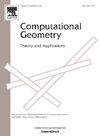四边形网格与多边形网格的距离有多近?
IF 0.7
4区 计算机科学
Q4 MATHEMATICS
Computational Geometry-Theory and Applications
Pub Date : 2023-04-01
DOI:10.1016/j.comgeo.2022.101978
引用次数: 0
摘要
我们计算局部连通性修改的最短序列,该序列将亏格0四元网格转换为多立方体。修改操作是(双重)循环保留的,因此,我们被限制为四元网格,其中循环不自相交,两个循环最多相交两次。循环的交集模式被编码在一个单纯复形中,我们称之为循环复形。为了公式化环复形上的修改搜索,我们组合地刻画了多边形,并确定了修改之间的依赖关系。我们证明了整个任务可以编码为混合整数问题,该问题由商品MIP求解器解决。我们通过一些不同复杂度的例子来证明实际的可行性。本文章由计算机程序翻译,如有差异,请以英文原文为准。
How close is a quad mesh to a polycube?
We compute the shortest sequence of local connectivity modifications that transform a genus 0 quad mesh to a polycube. The modification operations are (dual) loop preserving and thus, we are restricted to quad meshes where loops don't self-intersect and two loops intersect at most twice. The intersection patterns of the loops are encoded in a simplicial complex, which we call loop complex. To formulate the modification search over the loop complex, we characterise polycubes combinatorially and determine dependencies between modifications. We show that the full task can be encoded as a mixed-integer problem that is solved by a commodity MIP-solver. We demonstrate the practical feasibility by a number of examples with varying complexity.
求助全文
通过发布文献求助,成功后即可免费获取论文全文。
去求助
来源期刊
CiteScore
1.60
自引率
16.70%
发文量
43
审稿时长
>12 weeks
期刊介绍:
Computational Geometry is a forum for research in theoretical and applied aspects of computational geometry. The journal publishes fundamental research in all areas of the subject, as well as disseminating information on the applications, techniques, and use of computational geometry. Computational Geometry publishes articles on the design and analysis of geometric algorithms. All aspects of computational geometry are covered, including the numerical, graph theoretical and combinatorial aspects. Also welcomed are computational geometry solutions to fundamental problems arising in computer graphics, pattern recognition, robotics, image processing, CAD-CAM, VLSI design and geographical information systems.
Computational Geometry features a special section containing open problems and concise reports on implementations of computational geometry tools.

 求助内容:
求助内容: 应助结果提醒方式:
应助结果提醒方式:


